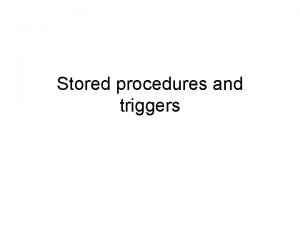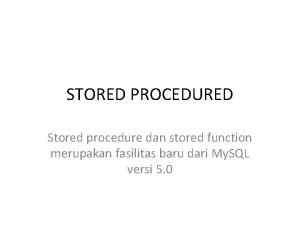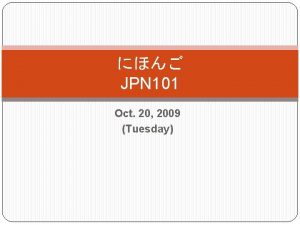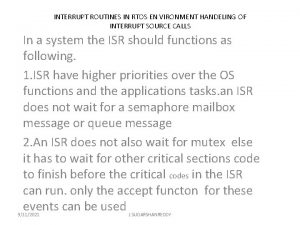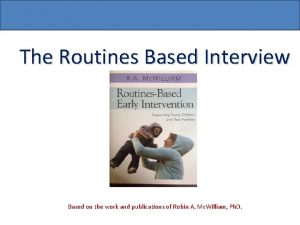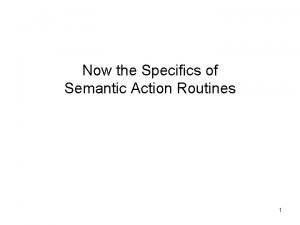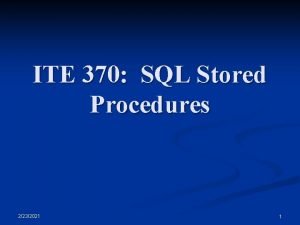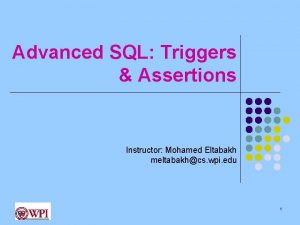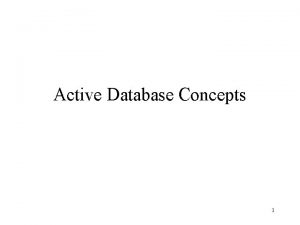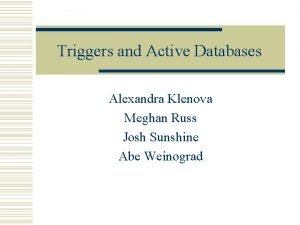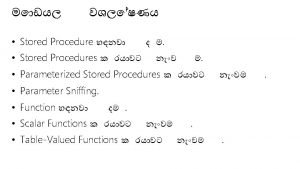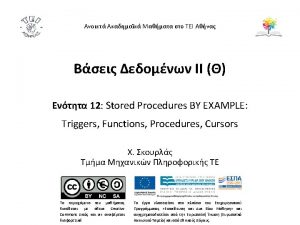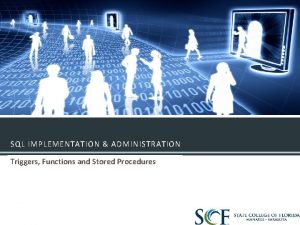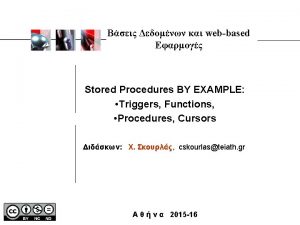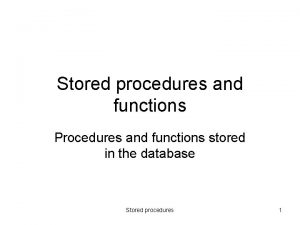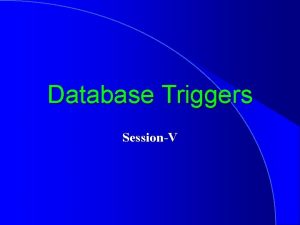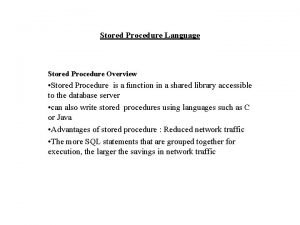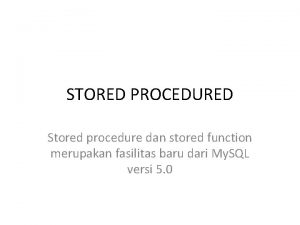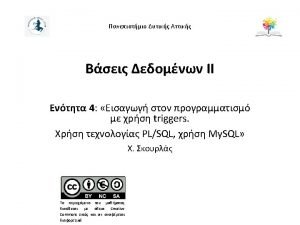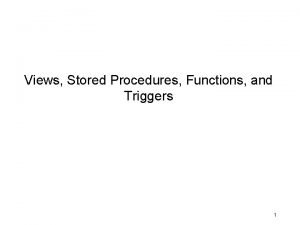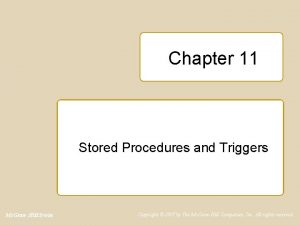Stored procedures and triggers My SQL Stored Routines



















- Slides: 19

Stored procedures and triggers

My. SQL Stored Routines • The routines are stored on server • They belong to database • They are based on standard SQL specification • Three main components are ü Procedure ü Function ü Trigger

My. SQL Stored Procedures • Parameter type ü IN ü OUT ü INOUT • The procedures may return one or more data sets as OUT parameters • It is possible to use dynamic SQL ü Dynamic SQL: construct dynamically statements as strings and then execute them

My. SQL Stored Functions • The My. SQL function has only input parameters • It must return one value of a given type • It cannot be used with dynamic SQL • It cannot return data sets

Example Procedure mysql> delimiter // mysql> CREATE PROCEDURE simpleproc (OUT param 1 INT) -> BEGIN -> SELECT COUNT(*) INTO param 1 FROM t; -> END; -> // Query OK, 0 rows affected (0. 00 sec) mysql> delimiter ; mysql> CALL simpleproc(@a); Query OK, 0 rows affected (0. 00 sec) mysql> DROP PROCEDURE simpleproc;

Example Procedure mysql> delimiter // mysql> CREATE PROCEDURE simpleproc (OUT param 1 INT) -> BEGIN -> SELECT COUNT(*) INTO param 1 FROM t; -> END; mysql> SELECT @a; -> // +------+ | @a | Query OK, 0 rows affected (0. 00 sec) +------+ mysql> delimiter ; | 3 | mysql> CALL simpleproc(@a); +------+ 1 row in set (0. 00 sec) Query OK, 0 rows affected (0. 00 sec) mysql> DROP PROCEDURE simpleproc;

Example Function CREATE FUNCTION hello (s CHAR(20)) RETURNS CHAR(50) RETURN CONCAT('Hello, ', s, '!'); Query OK, 0 rows affected (0. 00 sec) mysql> SELECT hello('world'); +--------+ | hello('world') | +--------+ | Hello, world! | +--------+ 1 row in set (0. 00 sec) mysql> DROP FUNCTION hello;

Value passing in Procedure CREATE PROCEDURE p (OUT ver_param VARCHAR(25), INOUT incr_param INT) BEGIN # Set value of OUT parameter SELECT VERSION() INTO ver_param; # Increment value of INOUT parameter SET incr_param = incr_param + 1; END; mysql> SET @increment = 10; mysql> CALL p(@version, @increment); mysql> SELECT @version, @increment; +------------+ | @version | @increment | +------------+ | 5. 1. 49 | 100 | +------------+

Flow Control • • • BEGIN. . END blocks IF. . . THEN. . . ELSE. . . END IF CASE. . . THEN. . . ELSE. . . END CASE WHILE. . . END WHILE REPEAT. . . UNTIL END REPEAT • LOOP. . . END LOOP • ITERATE label ü ITERATE can appear only within LOOP, REPEAT, and WHILE statements. ITERATE means “start the loop again. ” • LEAVE label

LOOP Example CREATE PROCEDURE doiterate(p 1 INT) BEGIN label 1: LOOP SET p 1 = p 1 + 1; IF p 1 < 10 THEN ITERATE label 1; END IF; LEAVE label 1; END LOOP label 1; SET @x = p 1; END;

Exception Handlers mysql> CREATE TABLE test (s 1 INT, PRIMARY KEY (s 1)); Query OK, 0 rows affected (0. 00 sec) mysql> delimiter // mysql> CREATE PROCEDURE handlerdemo () -> BEGIN -> DECLARE CONTINUE HANDLER FOR SQLSTATE '23000' SET @x 2 = 1; -> SET @x = 1; -> INSERT INTO test VALUES (1); -> SET @x = 2; -> INSERT INTO test VALUES (1); -> SET @x = 3; -> END; -> // Query OK, 0 rows affected (0. 00 sec)

Exception Handlers mysql> CREATE TABLE test (s 1 INT, PRIMARY KEY (s 1)); Query OK, 0 rows affected (0. 00 sec) mysql> delimiter // handler_action mysql> CREATE PROCEDURE handlerdemo () -> BEGIN -> DECLARE CONTINUE HANDLER FOR SQLSTATE '23000' SET @x 2 = 1; -> SET @x = 1; -> INSERT INTO test VALUES (1); -> SET @x = 2; -> INSERT INTO test VALUES (1); -> SET @x = 3; -> END; -> // Query OK, 0 rows affected (0. 00 sec)

Exception Handlers mysql> CREATE TABLE test (s 1 INT, PRIMARY KEY (s 1)); Query OK, 0 rows affected (0. 00 sec) mysql> delimiter // condition_value: duplicate-key error mysql> CREATE PROCEDURE handlerdemo () -> BEGIN -> DECLARE CONTINUE HANDLER FOR SQLSTATE '23000' SET @x 2 = 1; -> SET @x = 1; -> INSERT INTO test VALUES (1); -> SET @x = 2; -> INSERT INTO test VALUES (1); -> SET @x = 3; -> END; -> // Query OK, 0 rows affected (0. 00 sec)

Exception Handlers mysql> CALL handlerdemo()// Query OK, 0 rows affected (0. 00 sec) mysql> select @x, @x 2 // +------+ | @x 2 | +------+ | 3| 1| +------+ 1 row in set (0. 00 sec)

Cursor CREATE PROCEDURE curdemo() BEGIN DECLARE done INT DEFAULT 0; DECLARE a CHAR(16); DECLARE b, c DECIMAL(4, 2); DECLARE cur 1 CURSOR FOR SELECT id, data FROM test. data 1; DECLARE cur 2 CURSOR FOR SELECT data FROM test. data 2; DECLARE CONTINUE HANDLER FOR SQLSTATE '02000' SET done = 1; OPEN cur 1; No Data OPEN cur 2; REPEAT FETCH cur 1 INTO a, b; FETCH cur 2 INTO c; IF NOT done THEN IF b < c THEN INSERT INTO test. data 3 VALUES (a, b); ELSE INSERT INTO test. data 3 VALUES (a, c); END IF; UNTIL done END REPEAT; CLOSE cur 1; CLOSE cur 2; END//

My. SQL Triggers • A trigger is associated to table events (INSERT, UPDATE, DELETE) • Its parameters depend on the event • It does not return anything • It is not possible to use it with dynamic SQL • It cannot return data sets

DROP table s; CREATE TABLE s ( staffid VARCHAR(5) PRIMARY KEY, salary DECIMAL(6, 2) NOT NULL, work_done INTEGER NOT NULL, bonus INTEGER ); delimiter // CREATE TRIGGER salary_bi Trigger_time: BEFORE, AFTER BEFORE INSERT ON s Trigger_Event: INSERT, UPDATE, DELETE FOR EACH ROW BEGIN CASE WHEN new. work_done > 10 THEN SET new. bonus = 5000; WHEN new. work_done > 5 THEN SET new. bonus = 2500; WHEN new. work_done > 2 THEN SET new. bonus = 1000; ELSE SET new. bonus = 0; END CASE; Alias: OLD, NEW END// delimiter ; insert into s(staffid, salary, work_done) values ('s 01', 100. 0, 4);

My. SQL Triggers ü The OLD and NEW keywords enable you to access columns in the rows affected by a trigger. ü In an INSERT trigger, only NEW. col_name can be used -there is no old row. In a DELETE trigger, only OLD. col_name can be used -- there is no new row. ü In an UPDATE trigger, you can use OLD. col_name to refer to the columns of a row before it is updated and NEW. col_name to refer to the columns of the row after it is updated. ü A column named with OLD is read only. You can refer to it, but not modify it. A column named with NEW can be referred to if you have the SELECT privilege for it. ü In a BEFORE trigger, you can also change its value with SET NEW. col_name = value if you have the UPDATE privilege for it.

My. SQL Triggers • • If a BEFORE trigger fails, the operation on the corresponding row is not performed. A BEFORE trigger is activated by the attempt to insert or modify the row, regardless of whether the attempt subsequently succeeds. An AFTER trigger is executed only if the BEFORE trigger (if any) and the row operation both execute successfully. An error during either a BEFORE or AFTER trigger results in failure of the entire statement that caused trigger invocation.
 Triggers and routines in sql
Triggers and routines in sql Mssql ce
Mssql ce Stored procedure and stored function
Stored procedure and stored function Daily routines and adverbs of frequency
Daily routines and adverbs of frequency Ship routine
Ship routine Daily routines simple present tense
Daily routines simple present tense Interrupt routines in rtos
Interrupt routines in rtos Family guided routines based intervention
Family guided routines based intervention Innovative routines international
Innovative routines international Routines based interview
Routines based interview Pyp visible thinking routines
Pyp visible thinking routines Semantic routines
Semantic routines 2232021
2232021 Difference between sql and pl/sql
Difference between sql and pl/sql Triggers and assertions
Triggers and assertions Active database concepts and triggers
Active database concepts and triggers Triggers and active database in dbms
Triggers and active database in dbms Sql developer real time sql monitor
Sql developer real time sql monitor Seeking safety coping with triggers
Seeking safety coping with triggers Triggers of mass movement
Triggers of mass movement
